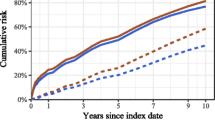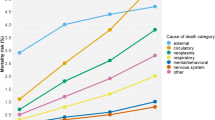Abstract
Summary
All-cause mortality risk persisted for 5 years after hip fractures in both men and women. There may be gender-specific differences in effect and duration of excess risk for cause-specific mortality after hip fracture.
Introduction
To determine all-cause and cause-specific mortality risk in the first 5 years after hip fracture in an Asian Chinese population.
Methods
The Singapore Chinese Health Study is a population-based cohort of 63,257 middle-aged and elderly Chinese men and women in Singapore recruited between 1993 and 1998. This cohort was followed up for hip fracture and death via linkage with nationwide hospital discharge database and death registry. As of 31 December 2008, we identified 1,166 hip fracture cases and matched five non-fracture cohort subjects by age and gender for each fracture case. Cox proportional hazards and competing risks regression models with hip fracture as a time-dependent covariate were used to determine all-cause and cause-specific mortality risk, respectively.
Results
Increase in all-cause mortality risk persisted till 5 years after hip fracture (adjusted hazard ratio, aHR = 1.58 [95 % CI, 1.35–1.86] for females and aHR = 1.64 [95 % CI, 1.30–2.06] for males). Men had higher mortality risk after hip fracture than women for deaths from stroke and cancer up to 1 year post-fracture but women with hip fracture had higher coronary artery mortality risk than men for 5 years post-fracture. Men had higher risk of death from pneumonia while women had increased risk of death from urinary tract infections. There was no difference in mortality risk by types of hip fracture surgery.
Conclusions
All-cause mortality risk persisted for 5 years after hip fractures in men and women. There are gender-specific differences in effect size and duration of excess mortality risk from hip fractures between specific causes of death.

Similar content being viewed by others
References
Johnell O, Kanis JA (2006) An estimate of the worldwide prevalence and disability associated with osteoporotic fractures. Osteoporos Int 17:1726–1733
Haleem S, Lutchman L, Mayahi R, Grice JE, Parker MJ (2008) Mortality following hip fracture: trends and geographical variations over the last 40 years. Injury 39:1157–1163
Kyo T, Takaoka K, Ono K (1993) Femoral neck fracture; factors related to ambulation and prognosis. Clin Orthop 292:215–222
Kitamura S, Hasegawa Y, Suzuki S, Sasaki R, Iwata H, Wingstrand H, Thorngren KG (1998) Functional outcome after hip fracture in Japan. Clin Orthop Relat Res 348:29–36
Nather A, Seow CS, Iau P, Chan A (1995) Morbidity and mortality for elderly patients with fractured neck of femur treated by hemiarthroplasty. Injury 26:187–190
Haentjens P, Magaziner J, Colón-Emeric CS, Vanderschueren D, Milisen K, Velkeniers B, Boonen S (2010) Meta-analysis: excess mortality after hip fracture among older women and men. Ann Intern Med 152:380–390
Jitapunkul S, Yuktanandana P (2000) Consequences of hip fracture among Thai women aged 50 years and over: a prospective study. J Med Assoc Thai 83:1447–1451
Hankin JH, Stram DO, Arakawa K, Park S, Low SH, Lee HP, Yu MC (2001) Singapore Chinese Health Study: development, validation, and calibration of the quantitative food frequency questionnaire. Nutr Cancer 39:187–195
Heng DM, Lee J, Chew SK, Tan BY, Hughes K, Chia KS (2000) Incidence of ischaemic heart disease and stroke in Chinese, Malays and Indians in Singapore: Singapore Cardiovascular Cohort Study. Ann Acad Med Singap 29:231–236
Collett D (2003) Modeling survival data in medical research, 2nd edn. Chapman and Hall, London
Tai BC, Machin D, White I, Gebski V (2001) Competing risks analysis of patients with osteosarcoma: a comparison of four different approaches. Stat Med 20:661–684
Tai BC, Wee J, Machin D (2011) Analysis and design of randomised clinical trials involving competing risks outcomes. Trials 12:127
LeBlanc ES, Hillier TA, Pedula KL, Rizzo JH, Cawthon PM, Fink HA, Cauley JA, Bauer DC, Black DM, Cummings SR, Browner WS (2011) Hip fracture and increased short-term but not long term mortality in healthy older women. Arch Int Med 171:1831–1837
Forsen L, Sogaard AJ, Meyer HE, Edna T-H, Kopjar B (1999) Survival after hip fracture: short and long-term excess mortality according to age and gender. Osteoporos Int 10:73–78
Kannegaard PN, Van der Mark S, Eiken P, Abrahamsen B, Excess mortality in men compared with women following hip fracture (2010) National analysis of comedications, comorbidity and survival. Age Ageing 39:203–209
Kado DM, Browner WS, Blackwell T, Gore R, Cummings SR (2000) Rate of bone loss is associated with mortality in older women: a prospective study. J Bone Miner Res 15:1974–1980
Ershler WB (1993) Interleukin-6: a cytokine for gerontologists. J Am Geriatr Soc 41:176–181
Papanicolaou DA, Wilder RL, Manolagas SC, Chrousos GP (1998) The pathophysiologic roles of interleukin-6 in human disease. Ann Intern Med 128:127–137
Harris TB, Ferrucci L, Tracy RP, Chiara C, Wacholder S, Ettinger WH, Heimovitz H, Cohen HJ, Wallace R (1999) Associations of elevated interleukin-6 and C-reactive protein levels with mortality in the elderly. Am J Med 106:506–512
Boushey CJ, Beresford SA, Omenn GS, Motulsky AG (1995) A quantitative assessment of plasma homocysteine as a risk factor for vascular disease. Probable benefits of increasing folic acid. JAMA 274:1049–1057
Lu-Yao GL, Baron JA, Barrett JA, Fisher ES (1994) Treatment and survival among elderly Americans with hip fractures: a population-based study. Am J Public Health 84:1287–1291
Giversen IM (2007) Time trends of mortality after first hip fractures. Osteoporos Int 18:721–732
Skinner P, Riley D, Ellery J, Beaumont A, Coumine R, Shafighian B (1989) Displaced subcapital fractures of the femur: a prospective randomized comparison of internal fixation, hemiarthroplasty and total hip replacement. Injury 20:291–293
Acknowledgments
We thank Siew-Hong Low of the National University of Singapore for supervising the field work of the Singapore Chinese Health Study and Renwei Wang for the maintenance of the cohort study database. We also thank the Ministry of Health in Singapore for assistance with the identification of hip fracture cases and mortality via database linkages. Finally, we acknowledge the founding, long-standing Principal Investigator of the Singapore Chinese Health Study — Mimi C Yu. This study was supported by the National Medical Research Council, Singapore (NMRC/EDG/0011/2007) and National Institutes of Health, USA (NCI RO1 CA55069, R35 CA53890, R01 CA80205, and R01 CA144034).
Conflicts of interest
None
Author information
Authors and Affiliations
Corresponding author
Rights and permissions
About this article
Cite this article
Koh, G.CH., Tai, B.C., Ang, LW. et al. All-cause and cause-specific mortality after hip fracture among Chinese women and men. Osteoporos Int 24, 1981–1989 (2013). https://doi.org/10.1007/s00198-012-2183-7
Received:
Accepted:
Published:
Issue Date:
DOI: https://doi.org/10.1007/s00198-012-2183-7




